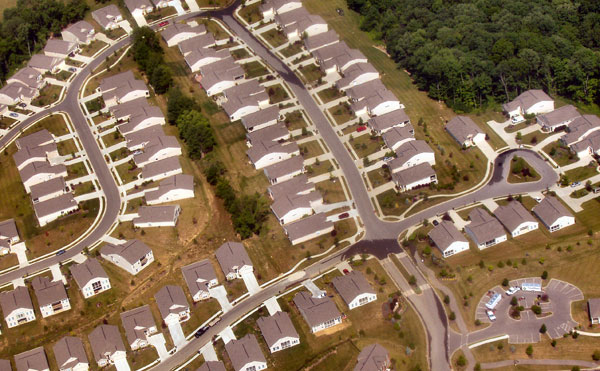How Low Can It Go?
So called Alt-a or liar loans that allowed buyers to skip downpaymets are tumbling and expected to get worse. Maybe there isn’t much sympathy for a
Jul 31, 2020581 Shares581.4K Views
Cincinatti housing development (cc)
So called Alt-a or “liar” loans that allowed buyers to skip downpaymets are tumbling and expected to get worse. Maybe there isn’t much sympathy for a houseflipper, but what about the neighbor next door?
That’s a reasonable question to ask about the housing crisis, given the recent divebombing of the market for Alt-A loans. Though the meltdown of the subprime market has grabbed headlines, the Alt-A loans – which are just a step below prime loans and include borrowers with decent credit – are in big trouble, too.
The Alt-A market began sliding a year ago as a surprising number of borrowers began to default, but it fell even more dramatically in the fourth quarter of last year. The default rate on these loans has doubled every month for the past 12 months. And as bad as all that sounds, it’s only expected to get worse.
Illustration by: Matt Mahurin
“It’s grim, and it’s going to get grimmer,” said Michael Youngblood, a managing director at FBR Investment Management Inc.in Arlington, Va.
Alt-A loans include a stew of what are now seen in hindsight as some of the dicier mortgage products offered during the housing boom. They include loans requiring no downpayments, or no proof of income or assets, sometimes called “liar loans.”Also in the mix: Interest-only loans. And Option ARMS, which gave borrowers the option of paying less than the monthly interest they owed.
People who took out these loans often had good enough credit to get prime loans, but the characteristics of the loans made them risker and more expensive than prime loans. They were especially popular with investors, houseflippers, and people buying expensive homes in hot markets; borrowers of these loans are the ones seen by policymakers as the most likely to walk away if prices continue to fall.
The Alt-A market’s problems aren’t just an obscure piece of the mortgage mess. They’re indicative of how deep and how wide the housing crisis has become, and how it has moved well beyond subprime borrowers. The investors and house flippers who took out these loans generally are excluded from efforts to modify mortgages and stave off foreclosures.
It’s not going to get better anytime soon. The crumbling of the Alt-A market, to many, is a sign that the housing mess has a long way to go before it hits bottom, and that it will be a bumpy and painful fall. Not to mention that people still seem to be in some sort of denial about it.
“The message here is that mortgage problems are continuing to rise and we are nowhere near the peak of defaults and foreclosures,” said Guy Cecala, publisherof Inside Mortgage Finance in Bethesda, Md. a trade industry publication. “Mortgage credit will continue to be tightened as mortgage losses from past loans rise. As a result, a good hunk of the people who got loans over the past three years, particularly nonconforming and nonprime loans, won’t be able to refinance or get better loans. They won’t be able to get any loans at all.”
Or, as Dean Baker,co-director of the Center for Economic and Policy Research in Washington, summarized it recently: “The folks who say the housing market will stabilize anytime soon must be smoking some really strong stuff.”
Some of the recent concern over the Alt-A market stemmed from an analysis of a pool of Washington Mutual Alt-A loans, which received widespread attention in the blogosphere. In a post entitled “Evidence of ‘Walking Away’ in WaMu Mortgage Pool,” blogger Mike Shedlock looked at some loans made in 2007 to borrowers with relatively decent credit scores of 705. He found that after eight months, 15 percent of the pool was in foreclosure or bank-owned – an unusually rapid breakdown. And he concluded the decline was aided by people choosing to walk away.
“The evidence suggests that people are walking away 30 or 60 days delinquent without even waiting for the foreclosure,” wrote Shedlock, whose blog, Mish’s Global Economic Trend Analysis, has a wide following among mortgage experts.
In a commentary for housingwire,mortgage industry veteran Richard Bitner said the pool painted a “disturbing picture” of the Alt-A market.”Credit scores north of 700 have not, in my experience, shown such poor performance levels so quickly,” Bitner wrote. “If ever there was a doubt that the phenomenon known as jingle mail actually exists, wonder no more. It’s alive and well.”
In an interview, Bitner said he wouldn’t be surprised to see such a quick pace of foreclosures among other Alt-A pools. “People have no idea what we’re in store for,” he said. “It’s going to get a hell of a lot worse.”
Reflecting that sentiment, FBR’s Youngblood said that Alt-A defaults early last year probably reflected poor underwriting standards and speculating by investors. But a sharp increase in the fourth quarter “cries out for a very different explanation,” he said. The rates rose from 1.65 in December 2006 to 7.20 percent by the end of the year. As employment lagged and housing prices fell, the worsening economy clearly played a role in the increase, Youngblood said.
“A real fundamental economic downturn is depriving borrowers of their livelihoods and accelerating the default rate,” he said. “It’s clearly sapping the willingness of many borrowers to pay on mortgage loans when prices have fallen below loan amounts.”
Treasury Secretary Henry M. Paulson recently addressedthis subject, saying people with negative equity, who owe more than their homes are worth, should just stay put. “Anyone who can afford his mortgage payment but chooses to walk away from an underwater property is simply a speculator – and one who is not honoring his obligations,” Paulson said.
He added that people who bought investment properties in hot markets should just take their losses, just like day traders did earlier in the decade. Even with rising defaults, Paulson said only about 2 percent of American households are in foreclosure. In addition, Alt-A defaults rates remain, so far, lower than those for subprime loans. The subprime default rate is about 23 percent.
But there are worrisome signs that the Alt-A loans are headed for more trouble. In what housingwire publisher Paul Jackson describesas “a week-end ritual during the credit crunch,” ratings agencies warn nearly every Friday that they might downgrade another pool of loans, and increasingly those comprise Alt-A securities. Just last Friday, Standard & Poors saidit might lower its ratings on $14 billion of securities backed by Alt-A loans, citing persistent delinquencies. In addition, Thornburg Mortgage Inc., which specialized in Alt-A loans and securities, is running out of money and may face bankruptcy.
Problems like these incite banks and lenders to tighten their lending standards even more to make up for losses on the pools. That means that falling house prices may seem like a buyer’s market – but only for some buyers. Lenders are likely to require more substantial minimum downpayments, often as much as 20 percent of the sale price, along with very high FICO scores of 750 or above, said Cecala, of Inside Mortgage Finance. That will leave more than a few potential buyers out in the cold, he said.
“What you’re going to find,” Cecala said, “is that nobody can afford to buy a home.”
In the meantime, the default rate on Alt-A loans is expected to reach 11.5 percent by the end of this year, “which is a very high number,” FBR’s Youngblood said.
Being an analyst, Youngblood has tried to measure how long a bubble takes to burst, and he puts it at 4.5 years. “The mortgage and housing markets are going to remain under pressure at least until the end of this decade,” he said. And he used to be an optimistabout the housing market.
So if you really want to know how low it can go, there’s one way to look at it.

Hajra Shannon
Reviewer
Latest Articles
Popular Articles

